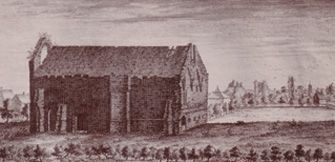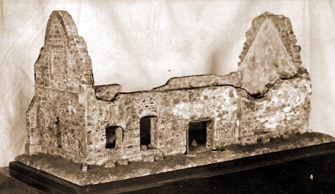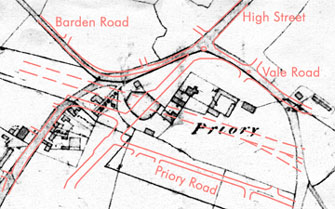

Tonbridge Priory, dedicated to Saint Mary Magdalene, was established in the late 12th century and existed for 350 years before being closed during the reign of Henry VIII. The priory ruins finally vanished under railway building in the 1840s. The site of the Priory was between the modern Vale Road and Priory Road where there is today a railway yard and car park, although in the 12th century this was out in the country on low lying ground to the south of Tonbridge Castle and the small settlement around the Medway crossing.

The remains of the Augustinian Priory, from a print of 1735. Tonbridge castle and parish church can be seen in the background. (THS7.001)
Richard de Clare, Earl of Hertford, who also held Tonbridge Castle, founded the Priory in about 1180 and a Papal Bull of Confirmation relating to the Priory was issued by Pope Celestine III in 1191. To support it the Priory was given various land revenues and grants including the right to graze 120 pigs in the Tonbridge forest and the gift of 2 cartloads of wood daily. In the 1291 taxation record these revenues totalled nearly £52 from properties not only in Kent but also in Sussex, Surrey and East Anglia.
J.F. Wadmore, in his 1882 publication*, describes the Priory as one of the finest monasteries in the Diocese of Rochester with a full range of buildings including a church, chapter house, dormitory, refectory and library. It provided a centre for a community of Augustinian canons who went out preaching and teaching in the surrounding area. Some idea of how well the canons lived is given in the food list for the Priory for a Christmas Day during the reign of Edward I (late 13th century). This included 200 loaves of bread, two quarters of beef, two pigs, two hams, six cockerels, one hundred herrings, one boar, three and a half casks of beer and some wine.

This scale model of the last remnants of the Priory was made out of actual stone from the Priory. (THS7.005)
Disaster, however, struck the Priory on 11th July 1337 when a fire broke out which destroyed all the buildings and valuables including books, vestments and ornaments. The Priory was rebuilt with support from the Archbishop of Canterbury, with grants of further revenues including the right to take over the church in Leigh. The Priory continued up to the reign of Henry VIII when it was one of 40 small priories and monasteries dissolved and sold by Cardinal Wolsey under an order of 1523 obtained from the Pope, with the money raised to be used to found Cardinal College at Oxford (later Christ Church).
Wolsey promised to provide Tonbridge with a free grammar school for 40 pupils in exchange for closing the Priory but at a meeting of townspeople they refused the offer, asking instead to keep the Priory. Wolsey fell from power while the issue was still being considered but the Priory was still closed, although Tonbridge was not to get its Grammar School until 1553 when Sir Andrew Judde founded the Free Grammar School which still exists today as Tonbridge School.

Buildings on the Priory site are shown in this 1838 map of south Tonbridge. Present-day roads and the railway (dashed) have been superimposed.
(Reproduced with the permission of Kent Libraries & Archives – Tonbridge Library)
Some Priory ruins survived into the 19th century and sketches of both the exterior and interior show them in the 1830s. Men digging for stone in the ruins in the 1820s found coffins and skeletons and supposedly, one of the coffins was acquired by James Alexander and put into the garden of his house at Somerhill. The ruins finally vanished when the railway reached Tonbridge in 1842 and the Priory site used for a goods yard despite attempts by townspeople to keep the ruins. The Priory site was shown on the 1838 Tithe map for Tonbridge, reproduced here from the copy in Tonbridge Reference Library, and was still marked on the 1897 Ordnance Survey map of the town. Further bones were found in 1934 when a new signal box was built. These were deposited in Tonbridge Historical Society archives in the 1970s but had not been kept under scientific conditions so no accurate data could be obtained from them, and in 2001 the bones were reburied at Tonbridge Cemetery.
*Wadmore's 1882 article about the Priory can be read on the Weald website